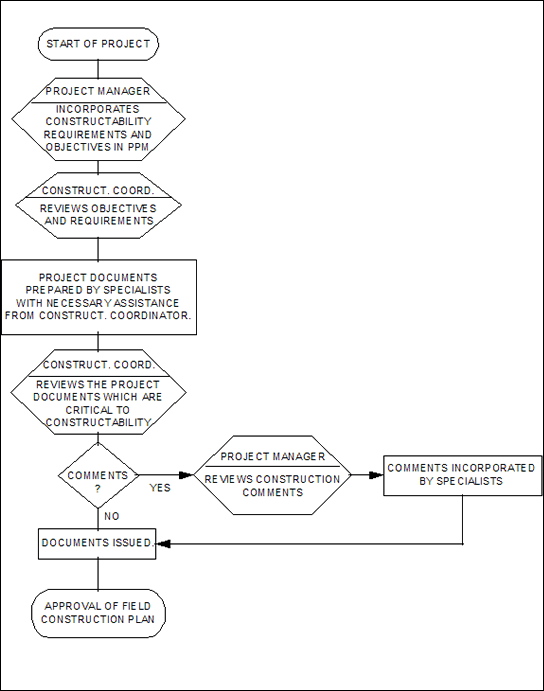Table of Contents
1. Purpose
1.1 This procedure is an instruction for the application of constructability in the execution of projects.
This procedure is applicable to all projects unless otherwise directed by the Project Manager.
2. General
2.1 What is Constructability?
"Constructability is the optimum use of construction knowledge and experience in planning, design, procurement and field operations to achieve overall project objectives. Maximum benefits occur when people with construction knowledge and experience become involved at the very beginning of a project".
This definition of constructability was issued by the Construction Industry Institute in the USA in their publications on constructability, as a result of a study on the subject. Company's constructability policy and procedure is based on these publications.
2.2 Implementation of Constructability
A constructability coordinator is assigned to each project by the Manager of Construction with approval by the Project Manager. The position may be full or part time, depending upon the size of the project.
The constructability coordinator will actively participate in project meetings, discussions, and reviews. He will collaborate with the Project Manager and other key project personnel on design, procurement and subcontracting issues affecting construction. Specifically he will examine the following issues as they relate to construction of the project:
- The subcontract plan
- Construction driven project schedule
- Simplified designs
- Standardization of design
- Module engineering/preassembly scoping
- Construction accessibility
- Adverse weather conditions
- Specifications.
2.2.1 Each of the above items will be considered in detail as follows by the Constructability Coordinator:
The subcontract plan will be developed to take maximum advantage of qualified subcontractor resources and capabilities to meet project goals and to minimize possible interferences between subcontractors and the site.
Construction Driven Schedule
Very early development of a construction schedule concentrating on field "need dates" is essential to inform the project of the construction critical path. This will encourage more realistic scheduling and help focus the project on the finished product.
Simplified Designs
Designs with minimum components and readily available materials will be encouraged. Also designs which minimise construction task interdependence and those capable of field dimensional adjustment will be maximised. Simpler designs will result in faster procurement and reduced field manhours.
Standardization
Reduced variations in design will be encouraged to increase field productivity, obtain procurement discounts, and to simplify field materials management.
Module Engineering/Preassembly Scoping
When developing the project construction plan, modularization of components and preassembly of units will be considered. An analysis of the cost and benefits of the construction method, for all or part of the project, will be undertaken in conjunction with the Project Manager and the key engineering and procurement project staff. Benefits of the method of construction include improved field productivity, quality control and safety.
Accessibility
The site layout will be examined to provide minimum spacing for project elements such as temporary facilities and laydown areas. Accessibility for heavy lifts and late placement of major equipment will be carefully considered. The primary objective of accessibility studies is to avoid construction bottlenecks which lead to loss of field productivity.
Adverse Weather Conditions
The field construction schedule will be developed to minimise exposure to temperature extremes and to reduce the schedule effect of precipitation as much as possible. Consideration will be given to enclosed and heated temporary structures as appropriate. The primary objective of a project weather analysis is to minimise field labour productivity losses due to adverse weather.
Specifications
A detailed review of the specifications will be made to promote more efficient field practices, economical material applications and reasonable tolerance requirements. Suggestions will be presented to the project engineering groups and the client as appropriate.
3. Responsibility
Responsibility for implementation of constructability rests with the:
-
Manager of Construction: To assign a Constructability Coordinator to the project.
-
Project Manager: To incorporate constructability in his project in accordance with this procedure.
-
Project/Speciality Engineers: To collaborate with the Constructability Coordinator in the implementation of constructability.
-
Constructability Coordinator: To provide constructability advise and reports to the Project Manager and task force members and to assist them in the implementation of these concepts.
4. Procedure
4.1 he Manager of Construction assigns a Constructability Coordinator to the project on a full or part time basis. The Constructability Coordinator reports to the Project Manager.
4.2 The Project Manager introduces the Constructability Coordinator to the project and ensures that he is placed on document distribution lists and is invited to participate in any project meeting or discussions related to construction.
4.3 The Project Engineer, Specialist Engineers, Procurement Specialist and Planner provide the Constructability Coordinator with information and drawings as requested by the coordinator to carry out his responsibilities.
4.4 The Constructability Coordinator offers recommendations to the Project Manager, Project Engineer, Specialist Engineers, Procurement Specialist and Planner where appropriate. Recommendations are offered in writing addressed to the appropriate task force member and copied to the Project Manager.
4.5 Recommendations by the Constructability Coordinator will be incorporated into the project execution plan if approved by the Project Manager.
5. Flowchart


